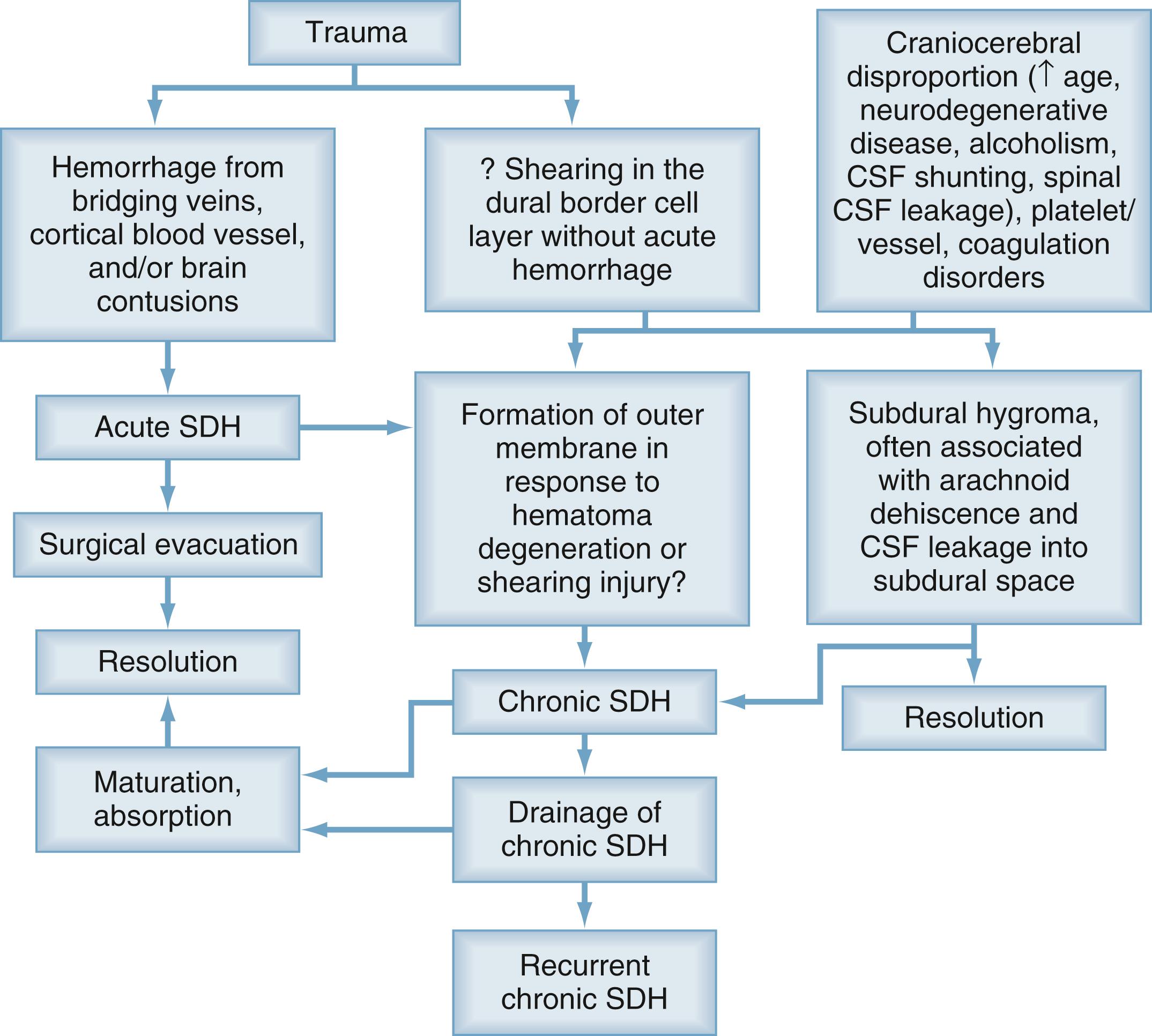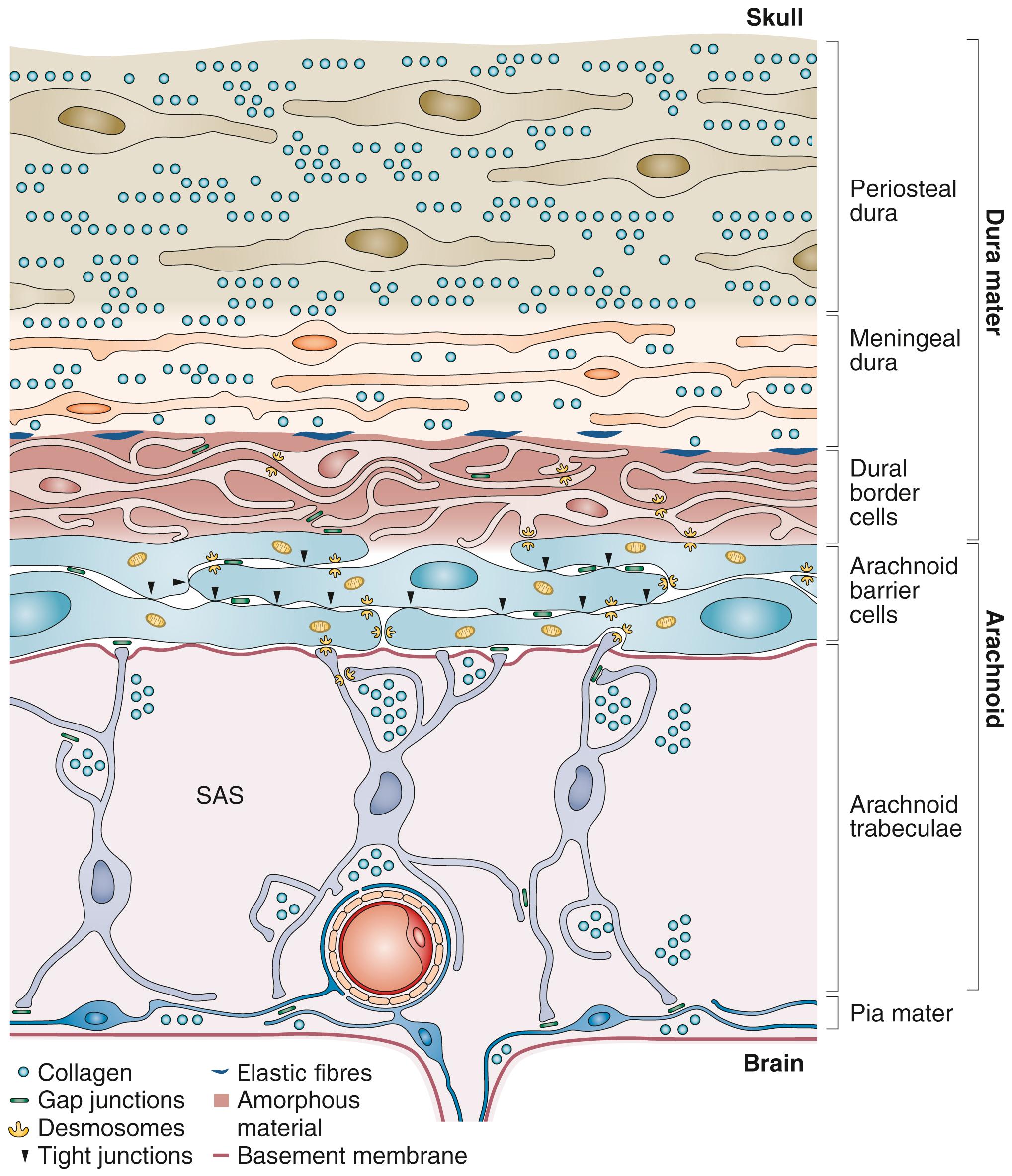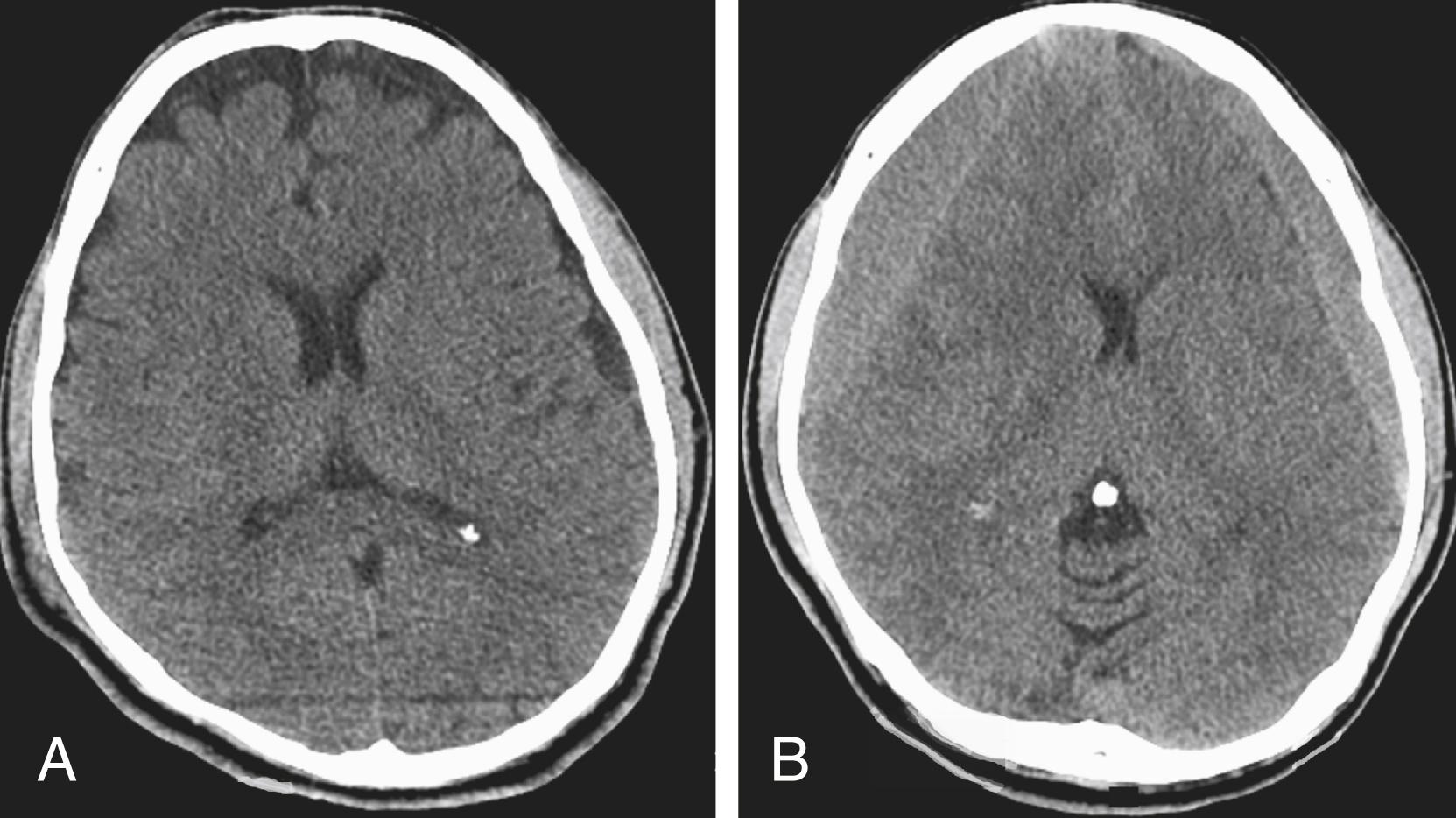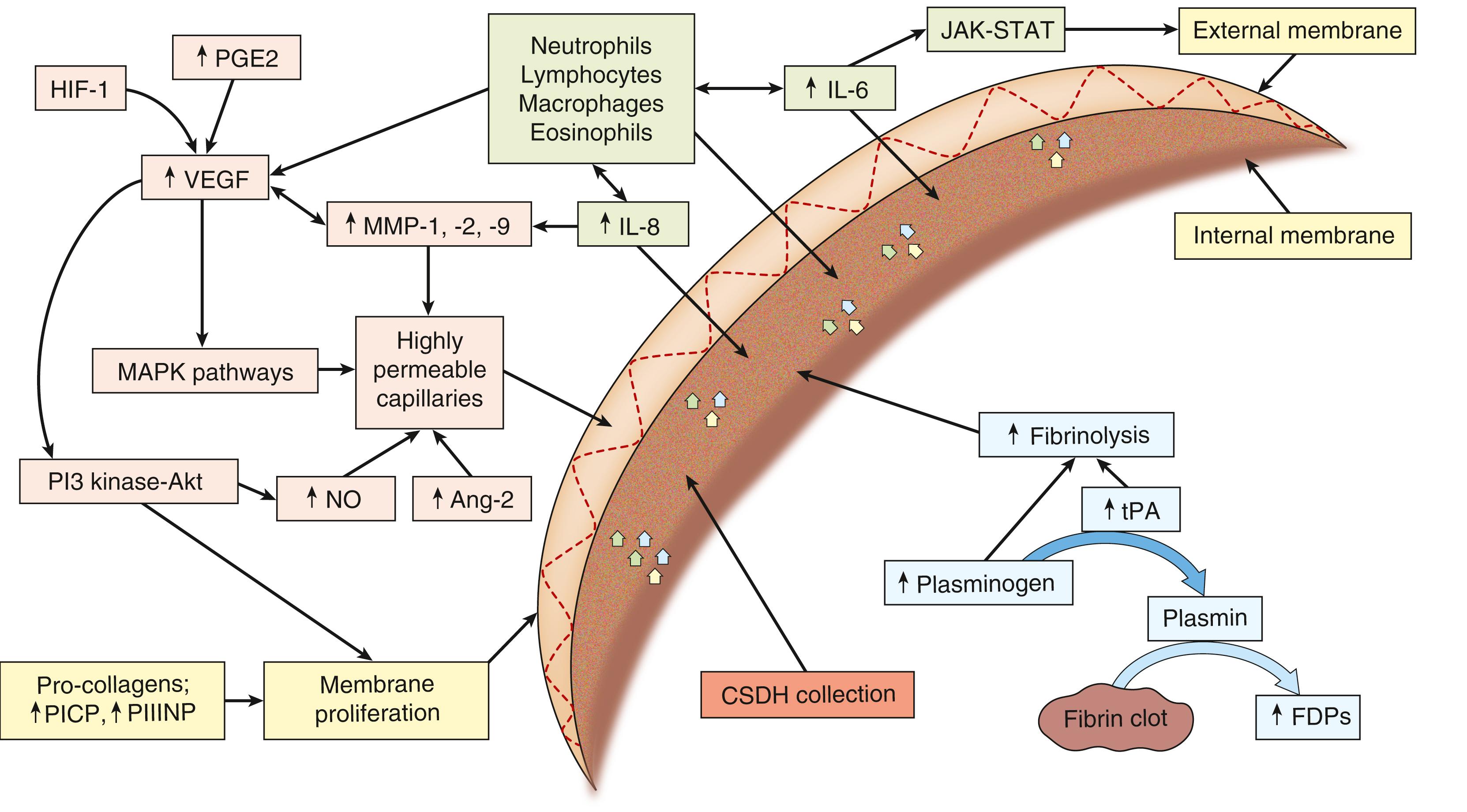Physical Address
304 North Cardinal St.
Dorchester Center, MA 02124
This chapter includes an accompanying lecture presentation that has been prepared by the author: ![]() .
.
The annual incidence of chronic subdural hematoma (CSDH) is approximately 20 per 100,000 and is increasing.
The etiology of CSDH is most likely inertial head injury resulting in shearing of the dural border cell layer.
The pathogenesis of CSDH is hypothesized to be bleeding into the dural border cell layer, which constitutes the potential subdural space. This is followed by a complex interplay of inflammation, formation of granulation tissue (similar to what occurs in wound healing), angiogenesis, fibrinolysis, and recurrent bleeding.
Osmotic and oncotic pressure differences between the CSDH and adjacent fluid spaces also contribute to enlargement of CSDH by exudation of fluid into the CSDH.
Chronic subdural hematoma (CSDH) has been defined as liquefied hematoma in the subdural space with a characteristic outer membrane that occurs (if known) at least 3 weeks after head injury. A subdural hygroma contains CSF and, in some definitions, is xanthochromic, which indicates that bleeding occurred at some point. Because the arachnoid may be dehiscent, some CSDHs contain CSF, and there is a spectrum of subdural collections from CSDH to hygromas or effusions. Because some CSDHs evolve from acute subdural hematomas, these entities also represent a spectrum.
The incidence of CSDH is not well known. On Awaji Island in Japan, the annual incidence of CSDH was 13 per 100,000 for 1986 to 1988 inclusive. It increased with age, from 3.4 per 100,000 annually among those younger than 65 years of age to 58 per 100,000 annually among those older. Balser and associates estimated the incidence from admissions to the Veterans Affairs hospital system in the state of New York between 2000 and 2012. They derived an age-standardized annual rate of 39 per 100,000. They found that 203 of 695 (29%) underwent surgery and that the recurrence rate was 11%. The annual incidence was 21 per 100,000 in the Miyagi Traumatic Head Injury Registry for 2005 to 2007 inclusive. The most common cause was motor vehicle crash in younger patients and ground-level fall in older adult patients.
Factors associated with increased risk for CSDH are as follows :
Increasing age
Alcohol consumption
Male sex
Use of anticoagulant or antiplatelet drugs
Alzheimer disease and other neurological diseases associated with brain atrophy
Systemic diseases associated with brain atrophy, such as liver and kidney disease
Dialysis
Conditions associated with craniocerebral disproportion, such as the period after ventriculoperitoneal shunting for hydrocephalus
Conditions associated with low intracranial pressure, such as lumbar CSF drainage and spontaneous intracranial hypotension (the latter often being secondary to spontaneous spinal CSF leakage)
Lumbar puncture
Spinal anesthesia
Spinal surgery complicated by dural tears
Beck and colleagues noted that older patients are more likely to develop CSDH as a result of minor trauma in association with brain atrophy, whereas younger patients (younger than 60 years of age) often present with no history of trauma and with minimal brain atrophy. In a consecutive series of 27 patients younger than 60 years of age who underwent surgery for CSDH, the authors searched for spinal CSF leakage and found a CSF leak in 7 patients (26%).
The most common theory for the cause of CSDH is that minor inertial brain injury causes movement of the brain within the skull and tears bridging veins as they traverse the cell layer of the dural border ( Figs. 46.1 and 46.2 ). Torn bridging vein stumps with clotted ends have been reported at surgery, although this is probably uncommon and is not usually observable because treatment is usually with a bur hole. In these cases, early CT scans show a hyperdense, acute subdural hematoma, and the CSDH evolves from this acute hematoma. About two-thirds of patients with CSDH report a history of trauma in the months before diagnosis.


There is no subdural space (see Fig. 46.2 ). The dura mater is separated from the arachnoid by a thin layer of dural border cells. The dural border cell layer contains flattened, elongated cells connected by desmosomes with amorphous extracellular matrix and limited extracellular fibers (i.e., collagen). This structure makes this cell layer a natural cleavage plane in which the dura mater is easily separated from the arachnoid. During craniotomy and opening of the dura, the most common plane of separation of the meninges is within the dural border cell layer. Evidence that CSDH forms in the dural border cell layer includes electron microscopic studies showing dural border cells in the outer and inner CSDH membranes. , ,
In addition, the walls of veins traversing from the cortex to the dura are thinnest where they pass through the dural border cell layer. Yamashima and Friede examined the ultrastructure of bridging veins in four human autopsy specimens. The segment of the veins traversing the dural border cell layer was thinner than the subarachnoid portion. The vessel walls were as thin as 10 μm compared with 50 to 200 μm in the subarachnoid space. The veins in this segment had a single layer of endothelial cells, only a thin layer of collagen in places, and no surrounding arachnoid trabeculae. As they traverse from the potentially mobile brain to the fixed points in the dural sinuses where they drain, they are thus predisposed to tearing in the virtual subdural space.
Development of CSDH from subdural hygroma was noted by Japanese neurosurgeons in the 1960s and 1970s and was presumed to result from CSF leakage into the dural border cell layer, which stimulates formation of the outer membrane granulation tissue ( Fig. 46.3 ). ,

Another hypothesis about the evolution of subdural hygroma to CSDH is that any shearing injury to the dural border cell layer, including hemorrhage from bridging veins, CSF accumulation, or even shearing forces associated with normal activities in patients predisposed by platelet/vessel or coagulation disorders or craniocerebral disproportion, can incite a wound-healing response that leads to CSDH. In support of this hypothesis are cases in which an older adult patient has a minor head injury. An initial CT scan on the first day or so appears unremarkable, but the patient returns weeks later with a CSDH ( Fig. 46.4 ). Also, only about two-thirds of affected patients recall a head injury. This suggests that more minor daily activities, such as coughing and straining or even increased tension on the dural border cell layer in the setting of brain atrophy, could cause shearing through this layer, inciting a wound-healing response. Incidental findings of thin subdural neomembranes in 46 of 1044 (4%) consecutive autopsy specimens support this but do not exclude the possibility that a forgotten trauma led to a CSDH that spontaneously resolved. ,

Congenital and acquired platelet/vessel and coagulation disorders are associated with increased risk for CSDH as well as recurrence after surgery. ,
Become a Clinical Tree membership for Full access and enjoy Unlimited articles
If you are a member. Log in here